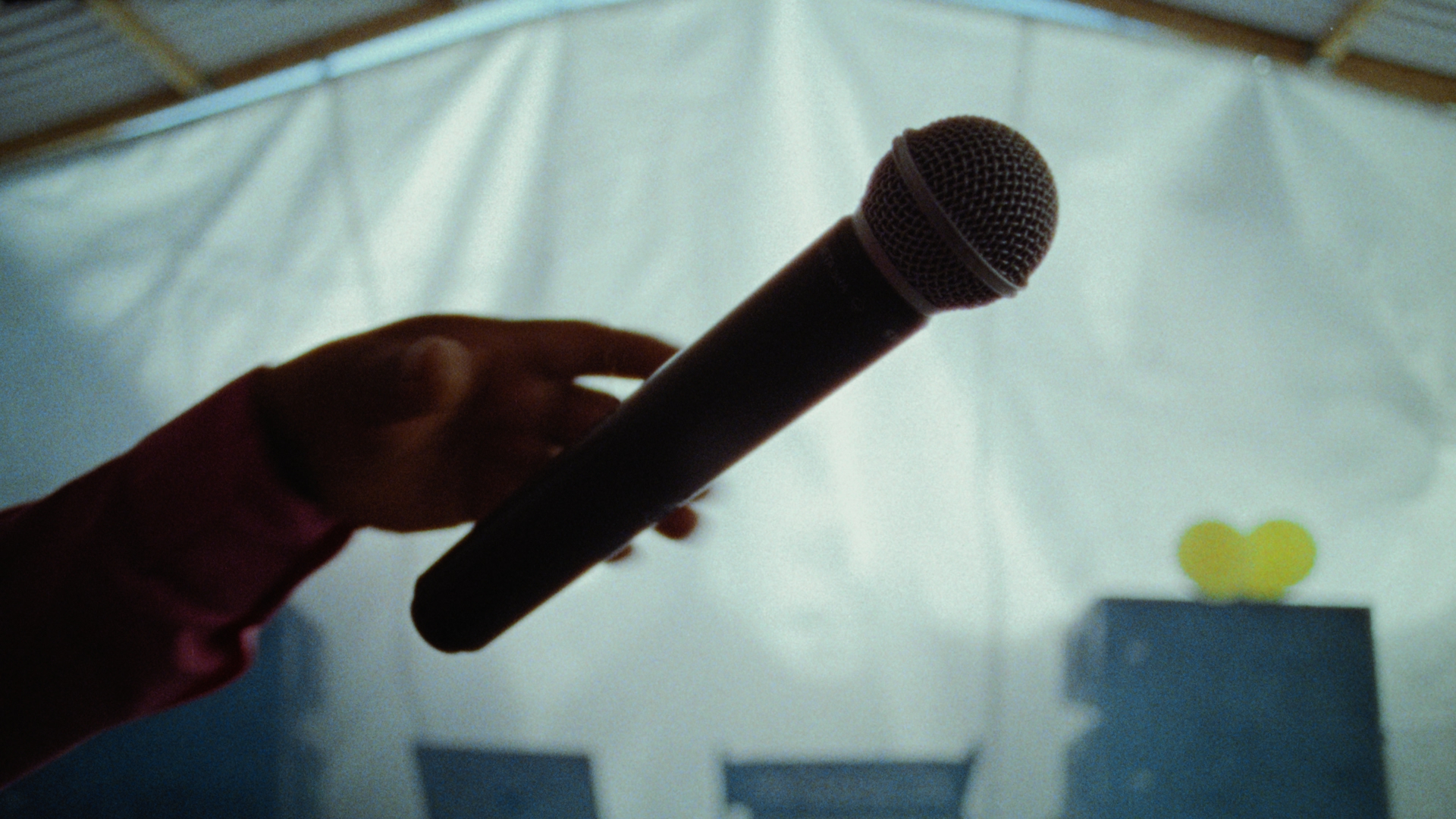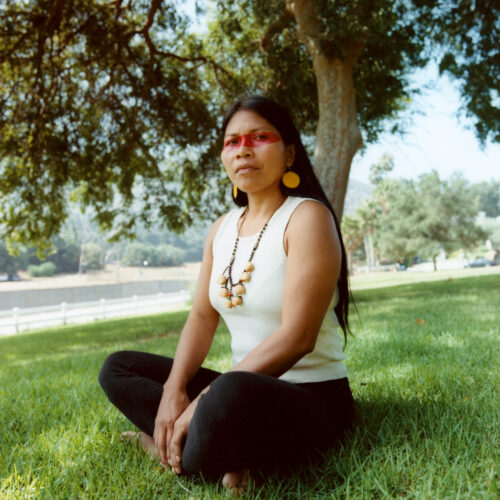The phenomenon of sonideros, or cumbia dances led by sonidos (DJs), is a product of Mexico City’s late 1950s music scene. What started as humble street dances in working class neighborhoods, led by DJs spinning cumbia records on homemade sound systems (many resembling the towers of Jamaican sound system culture) has expanded well across the southern border by way of mass immigration in the 1990s and early 2000s. Far from glamorous but brimming with energy, a sonidero is marked by explosive speakers, cascading rainbow lasers, and a thick crowd of dancers in step with the cumbias of their generation. In fact, it’s now a thriving nightlife scene in Queens, New York, where sonideros have become a long-standing tradition for Mexican immigrants and their descendants.
At sonideros, a place where roaring speakers and ceaseless dancing are the only rules, celebrating the culture is top priority. More so than a “regular” DJ, the sonido is expected to be constantly engaging with the audience by way of saludos, or shoutouts, often requested via hand-written notes from the crowd. Each sonido has their own style, equipment, and personal brand; some purists sticking to well-tried cumbia classics and others weave new-wave pop and reggaeton into their setlists.
In the new short film Barrio Sonidero, by Mexican-American director Leo Aguirre, one sonido featured shares the importance of these clubs to the community. “It’s really beautiful to hear [someone say], ‘I just arrived from Mexico, from the barrio, from the main roots of the sonidos,’ [but] they think that their culture is going to be lost because they are coming [to the United States]. They think [the US] is limited musically, but it’s not. The culture is also here. We are preserving it. And we want this sonidero culture to be preserved for all of us.”
Aguirre’s 2020 breakout film, No Somos De Aqui Ni Somos De Alla, is an electrifying short documentary portraying the layers of the American immigrant identity. Created along the southern border in Texas, the film layers vignettes of young Mexican-Americans who share the experience of not feeling from neither here, nor there.
Barrio Sonidero is a continuation of Aguirre’s lyrical documentary style. The short film, which recently premiered on Nowness, takes the viewer into the sonideros of Queens to explore the cultural importance of sonideros among the Mexican-American community.
LATINA spoke with Aguirre to discuss sonidero culture, portraying the immigrant identity in film, and the surprising migratory evolution of the cumbia genre, from Latin America to the southern United States and back.
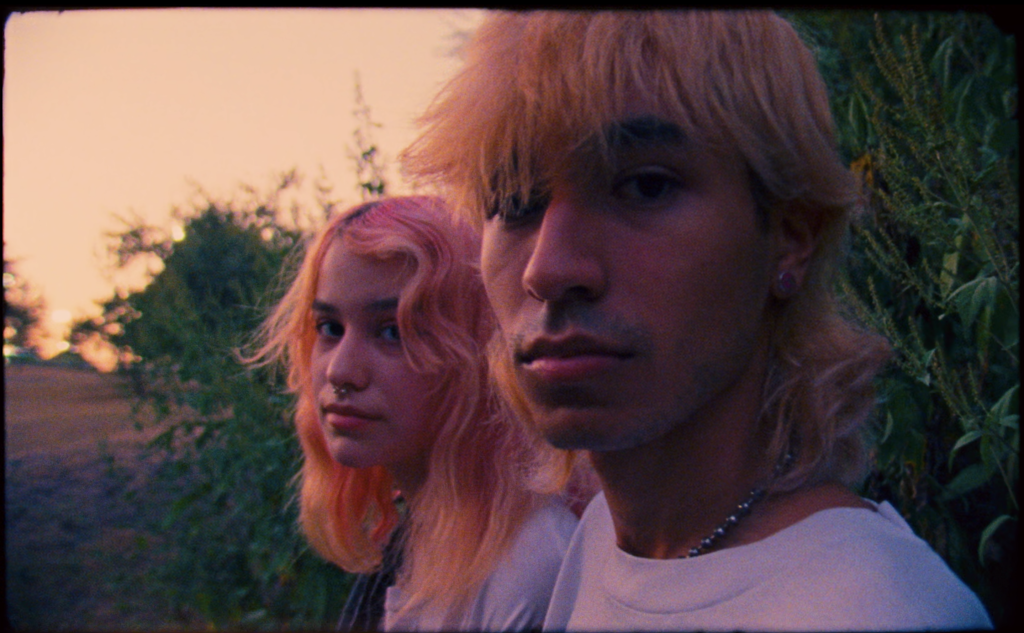
No Somos De Aqui Ni Somos De Alla (2020) by Leo Aguirre
This conversation has been edited for length and clarity.
Your last short film, No Somos De Aqui Ni Somos De Alla, weaved the nuances of Mexican-American identity together with such unique style. Tell us about your background as a Mexican-American growing up in Texas, and the influence your upbringing has had on your work.
I was born and raised in El Paso, Texas, and Ciudad de Juárez, where my mom’s family lived. I was going back and forth, so I say I spent my childhood along the border. We moved around Texas a bit, and I discovered that there were multitudes to this experience of being Latinx or Hispanic. I remember being really curious about people who had very Latin names like Juan Sanchez, but didn’t speak a lick of Spanish.
[Not appearing stereotypically Mexican] really changed my understanding of the Latin American experience. I think there is such a gradient to how [people] experience that, and how your family has navigated and assimilated [to the US].
As I got older, I realized these people’s parents maybe chose not to teach them Spanish when they were growing up. Sometimes it’s out of necessity, you know? I hadn’t been to other parts of the border, but we went to Brownsville, Texas to shoot No Somos De Aqui Ni Somos De Alla. It was really beautiful to see all these different experiences that people had along the border. We shot a large portion of that film in Austin as well and we saw so many people who didn’t “look” stereotypically Mexican. That experience really changed my understanding of the Latin American experience. I think there is such a gradient to how [people] experience that, and how your family has navigated and assimilated [to the US].
The childhood experience for immigrants can be so different in that you had so much proximity to your culture in Texas, where others may have the opposite depending on where they grew up. How would you say that influenced your childhood?
I think that’s a big thing for a lot of people. We lived in the panhandle for a while, in North Texas, close to Oklahoma. The year before I moved there, we learned there had been this mass deportation at a meatpacking factory. ICE came through and deported like two hundred people while their kids were in school. So there was this sense that people were afraid of [identifying as Mexican].
I had friends who were living with an uncle or an aunt, and they didn’t openly talk about it, but it was understood that their parents had been taken away. You could feel it in the air. It was sad to get older and understand [what had happened], and then I began to reckon with people labeling me as Mexican here, but as a gringo when I go back to Mexico. For a long time I had a hard time wrapping my head around having these two identities. [No Somos De Aqui Ni Somos De Alla] was meant to embrace that. I am these two things and I can hold these things simultaneously.
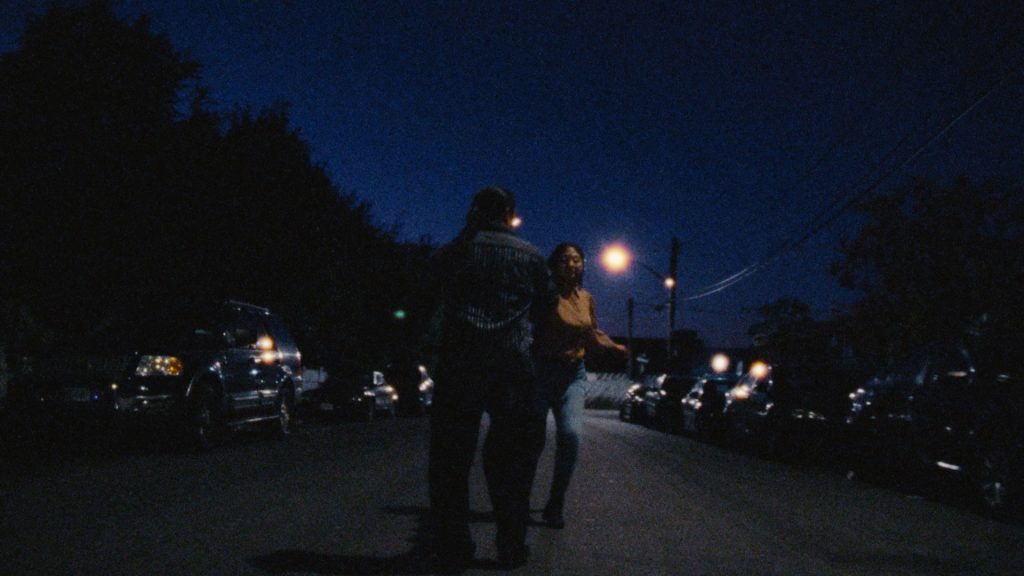

Barrio Sonidero (2022), directed by Leo Aguirre
Identity is already such a struggle to form, and when you’re a child of immigrants, there’s even more to reconcile. I noticed that there are a few of these through lines from No Somos De Aqui Ni Somos De Alla in your new film Barrio Sonidero. How did this project come about?
Nowness partnered with the dance center, Jacob’s Pillow, to create the film series called Body Language, featuring various kinds of dance around the world. They reached out to me looking for a director for this project about sonideros in New York City. I had heard of sonideros but had never been to one. So I [said I’d love to direct the project], and we just started going to them. In a way, the through line in this piece is an understanding that there are certain parts of people’s identity that they want to hold on to [after leaving] their home countries. It was really beautiful to see this physical manifestation of that idea, of preserving a part of your identity.
There were kids wearing their Nike AirMaxes and dancing cumbias. They might be going home and listening to Frank Ocean, but they’re spending their weekend at sonideros dancing cumbias. That was really cool to see.
When I first heard about the sonideros I thought they were going to be these really large gatherings for a lot of undocumented people who are new to the country. That is the case, but half of the people there were Mexican-Americans, many first or second generation, so it was this hybrid of people who were wanting to connect to their culture and to the music. There were kids wearing their Nike AirMaxes and dancing cumbias. They might be going home and listening to Frank Ocean, but they’re spending their weekend at sonideros dancing cumbias. That was really cool to see.
The way the media portrays immigrants and indigenous folks often falls under victim culture; the tragedy narrative, as if they don’t have agency. Now, we see a dialogue with people wanting to see indigenous joy, black joy, etc. It’s important to see [immigrants] as people who are capable of celebrating their lives. So it was really important in this documentary to show people having a great time at these sonideros.
Love the image of millennials listening to softboy pop on their way home from the sonidero. How many clubs did you go to during the shoot?
We went to three clubs and we probably saw seven DJs. The headliner comes on at [around] midnight, and they have to provide all the lights and the rigging in the space. It’s really interesting because they don’t just show up and play, they roll up in a truck with all the equipment.
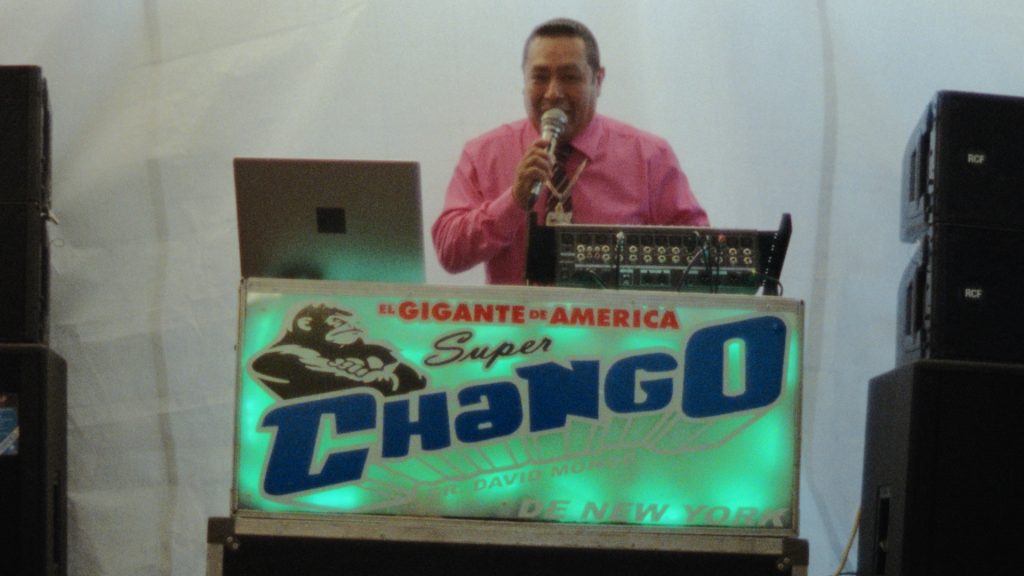
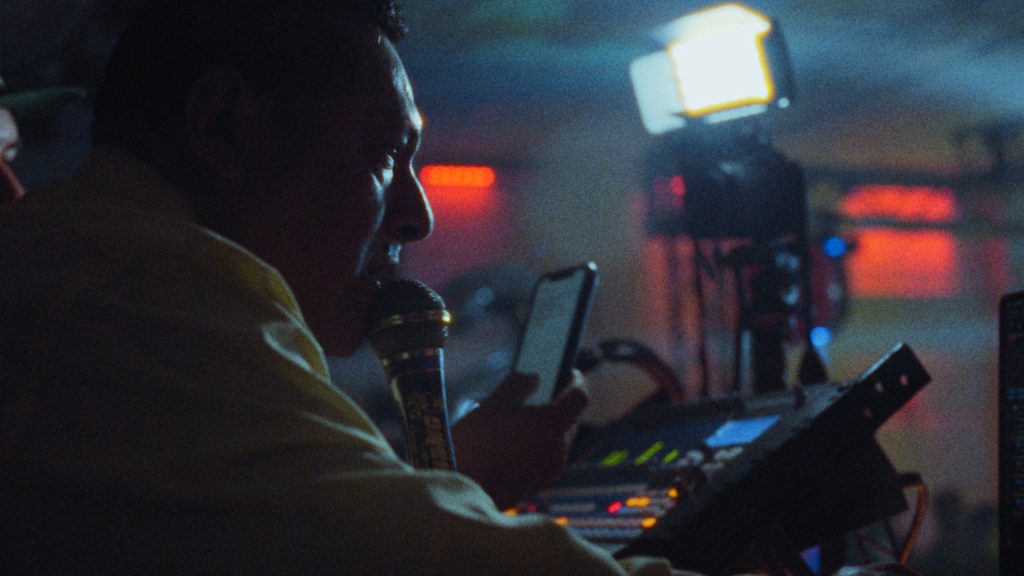
DJ Super Chango in Barrio Sonidero (2022) , directed by Leo Aguirre
And the sound systems themselves are a whole culture as well. There’s an amazing book on that called Ojos Suaves by Mirjam Wirz, do you know it?
Yeah, I know that book. I actually used some of her photos as references. [The sonidos] bring all of that stuff themselves, it’s as if you were closing out Coachella and they tell you that you have to bring all of the equipment.
We featured a sonido in the piece who goes by Sonido Super Chango. By night, he congregates over two or three hundred people and curates a spectacular event, but by day, he stocks stores with pastries. We went to his house, met his family, and saw his garage where he keeps all the equipment — all the lights, trusts, everything. There’s this campiness to [sonideros] that’s kind of endearing.
We also met all these dancers, this one guy is doing this crazy move in the piece where he’s bending backwards. He is actually a very controversial person in the community because he practices pasos prohibidos, or forbidden steps. He’s dancing cumbia but in a way that’s very unconventional, so people get pissed off at him. He’s this character who’s really interested in being an innovator and taking cumbia to another place. He’s actually gone viral, there are memes about him in the sonidero community. He’ll start doing pushups in the middle of a dance. He was my favorite person that we met. Going into the documentary I had a very specific idea of what it was going to be, but as we were meeting these people, I realized everyone’s story is so nuanced and special.
There’s this thing called “Barrio Sonidero TV” on Youtube, where this guy posts videos of people dancing at these parties. A big part of these events is that there are cameramen who are shooting people dancing. They walk around the dance floor with a DSLR and a light, and there’s a camera set up on the DJ booth at all times.
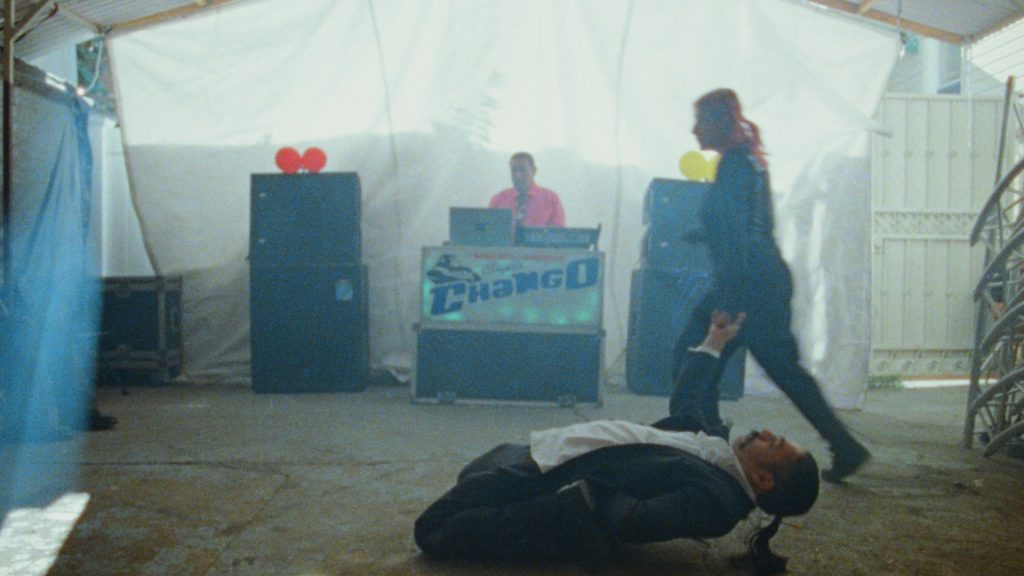
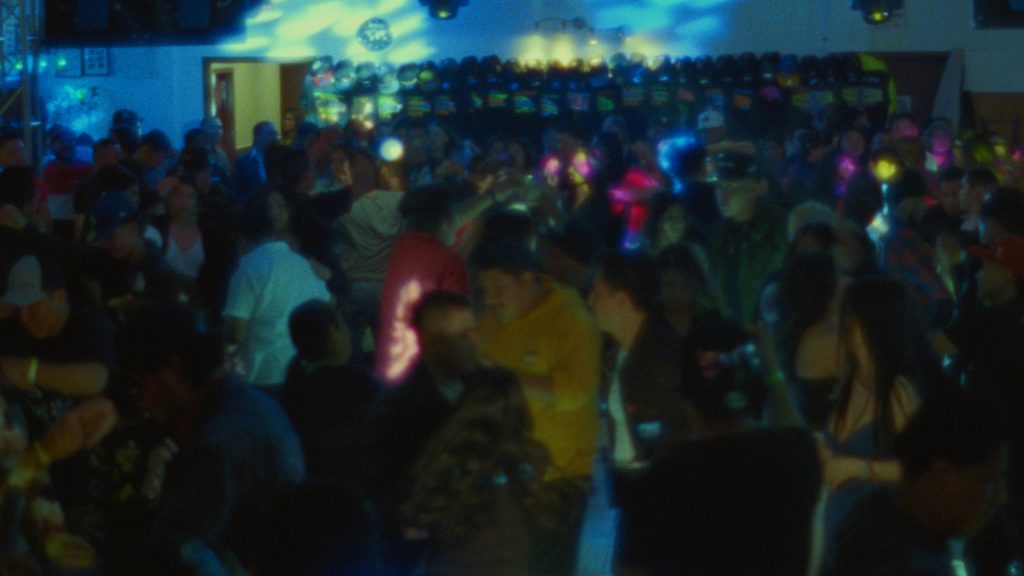
Barrio Sonidero (2022), directed by Leo Aguirre
It’s like a boiler room set! Did that inspire how you chose to shoot it?
Yeah, my friend Jasmine Romero shot some footage on a camcorder to pay homage to that part of it. And actually, when I called Humberto, who runs the Youtube channel, he was delivering groceries. His day job is as a delivery driver but he moonlights as this Youtuber with fifteen thousand subscribers. That added so much dimensionality to this person. You know, we see the NYC delivery guys on their bikes all the time and we never think about how much depth there may be to these people and what they’re up to after work. We actually shot some footage of him on his bike but we had to cut it out of the final edit. There’s so much more footage that we couldn’t use because of time constraints.
In the film, you used voice-over interviews to describe sonidero culture as means of cultural preservation. Places like churches and sonideros serve as safe spaces in a country that actively terrorizes immigrants. What was the energy like in these clubs?
So, we went to this popular club in Queens. I’m sure most of them are like this, but this one had a lot of security, although from the outside you wouldn’t expect that there’s a huge party inside. I think it’s meant to be a very protected space. It was a mix of young people and older people, and everyone’s dressed very casually. But later on, it got pretty lit, pretty rowdy.
It felt super familial and celebratory of the culture. In this environment, it’s just about dancing. At an electronic club, you know, if you’re dancing with someone it may not be interpreted as platonic. But at this sonidero, there was a general understanding that you’re here to have a good time and you can dance with anyone you want. People are sweaty, people are having a great time. It didn’t feel like we were overstepping [by filming], although we were cautious to not show the name of the clubs we went to. I think it should be shared, but I’m highly aware of not wanting to blow up spaces where it’s not my place. But everyone there was so welcoming.
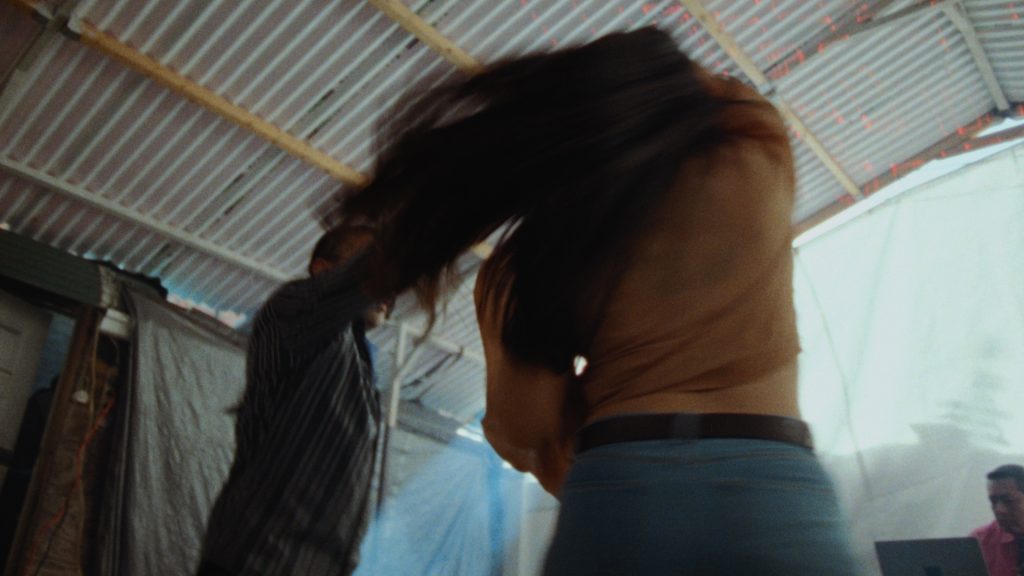

Barrio Sonidero (2022), directed by Leo Aguirre
Did you get to dance at all?
We got to sneak in a bit of dancing, yeah. It felt like I was connecting with something that I hadn’t connected with in the culture. Also, cumbias are Colombian.
They come from Colombia but they’re so international, they’re all over Mexico and Cuba.
There’s a film called Ya No Estoy Aqui about a kid who gets displaced from Monterrey to the US, and in it they dance cumbias rebajadas. I was reading about how that music came to be and about Colombia being an exporter of cumbia to Mexico City, and from there [cumbias] made their way to Houston, Texas. Houston pioneered lean rap, which is rap that is slowed down. So as a result of [the lean rap] movement, musicians there began making cumbias that were slowed down. That made its way back to Monterrey, which is where that phenomenon of cumbias rebajadas has materialized. It’s funny to see how music migrates and changes and is affected by different genres.
What’s next for you? Do you have plans to continue making films around the themes of multiculturalism, immigration and identity?
I want to make [films] where the cultural aspects are in the background and it’s not so much about identity. [For this film], Nowness and I went back and forth about addressing the fact that there’s an assault on immigration happening in this country right now. I was like, I get it, but that’s not what [this film] has to be about. This is about this community being joyous and enjoying this congregation and this music, so we ended up deciding to focus on the dance part.
Making this documentary has reinforced the way I want to explore subject matter that deals with identity; never looking at a character’s journey or at their story as something monolithic or representative of everyone’s experience. I love stories and characters that might exist in the periphery, but also in the gray between the black and white, never conforming to the one dimensional character that society at large expects them to be.
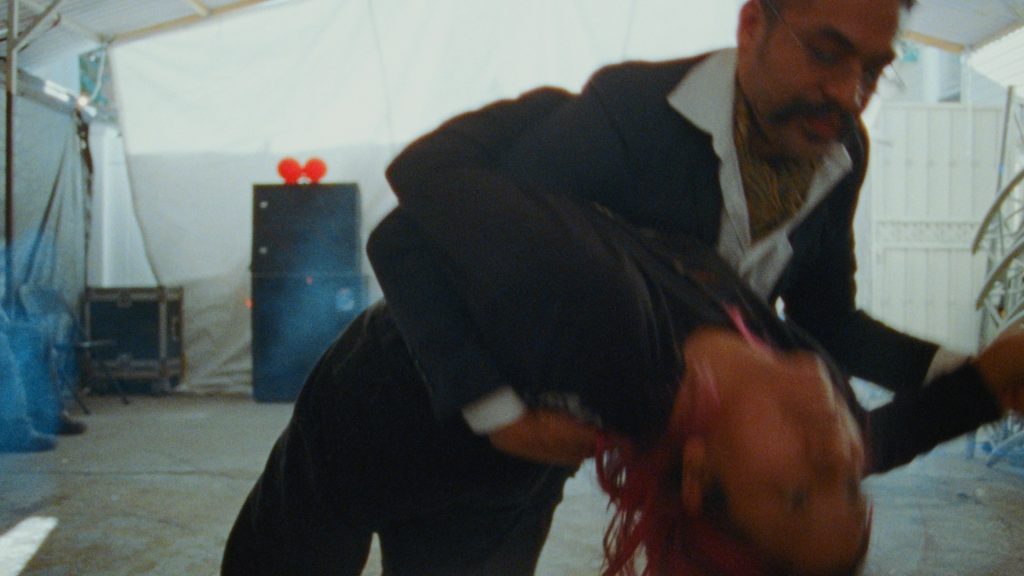
Barrio Sonidero (2022), directed by Leo Aguirre
You can watch Leo’s film Barrio Sonidero on Nowness.
